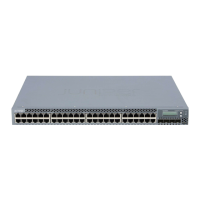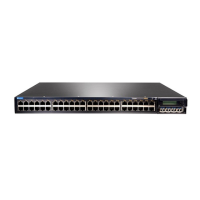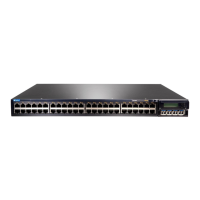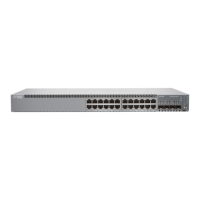If the remote end of the LAG link is a security device, LACP might not be supported
because security devices require a deterministic configuration. In such a scenario, do not
configure LACP. All links in the LAG are permanently operational unless the switch detects
a link failure within the Ethernet physical layer or data link layers.
Related
Documentation
Understanding EX Series Virtual Chassis Port Link Aggregation•
• Understanding Link Aggregation in an EX8200 Virtual Chassis
• Understanding Redundant Trunk Links
• Configuring Aggregated Ethernet Links (CLI Procedure) on page 82
• Configuring Aggregated Ethernet LACP (CLI Procedure) on page 86
• Configuring LACP Link Protection of Aggregated Ethernet Interfaces (CLI Procedure)
on page 87
• Junos OS Network Interfaces Configuration Guide
Understanding the Algorithm Used to Hash LAG Bundle and Egress Next-Hop ECMP
Traffic
Juniper Networks EX Series and QFX Series use a hashing algorithm to determine how
to forward traffic over a link aggregation group (LAG) bundle or to the next-hop device
when equal-cost multipath (ECMP) is enabled.
The hashing algorithm makes hashing decisions based on values in various packet fields,
as well as on some internal values like source port ID and source device ID. You can
configure some of the fields that are used by the hashing algorithm.
This topic contains the following sections:
•
Understanding the Hashing Algorithm on page 11
•
IP (IPv4 and IPv6) on page 12
•
MPLS on page 14
•
MAC-in-MAC Packet Hashing on page 15
•
Layer 2 Header Hashing on page 15
Understanding the Hashing Algorithm
The hashing algorithm is used to make traffic-forwarding decisions for traffic entering a
LAG bundle or for traffic exiting a switch when ECMP is enabled.
For LAG bundles, the hashing algorithm determines how traffic entering a LAG bundle is
placed onto the bundle’s member links. The hashing algorithm tries to manage bandwidth
by evenly load-balancing all incoming traffic across the member links in the bundle.
For ECMP, the hashing algorithm determines how incoming traffic is forwarded to the
next-hop device.
11Copyright © 2015, Juniper Networks, Inc.
Chapter 1: Interfaces Overview
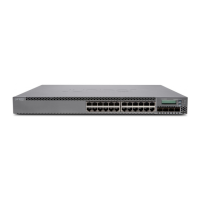
